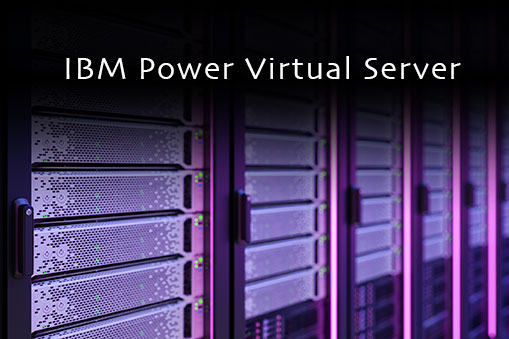Ron Gordon
Director, IBM Power Systems
The use of the IBM Power Virtual Server (aka PowerVS or IBM Power Systems in the IBM Cloud) is growing daily. Power 922’s and Power 980’s with POWER9 processors, memory, and SAN storage supporting IBM i, AIX, and Linux operating systems are attracting more Power Systems users who are finding Power VS to be the best solution in the cloud market. SAP HANA users are also expressing more interest in PowerVS as it’s the only certified cloud solution for SAP HANA workloads. The Power Systems in the IBM Cloud can also utilize IBM Cloud storage, access x86 systems in the IBM Cloud or a multi cloud environment, and truly provide an IaaS environment to meet business requirements.
Previously the cloud capabilities did not match the capabilities of on-premises Power systems which created an inhibitor to migrating Power workloads to the cloud. The missing capabilities included:
- “Tape” support (for back up and archive requirements)
- Hardware replication performed by the underlying storage hardware. Software replication is costly and does not provide the best RTO and RPO based on processing and networking limitations.
- Cost effective and efficient High Availability (HA) and Disaster Recovery (DR) solutions
The recent announcement of enhancements to the IBM Power Systems in the IBM Cloud address these inhibitors and those of you that viewed the IBM PowerVS as a limited solution to cloud adoption due to missing capabilities, high costs, lacking functionality and poor performance should look again.
Enhancements
FalconStor Storsafe VTL.
First, IBM PowerVS has upgraded the “virtual tape” support by changing VTL capability from DSI to the FalconStor Storsafe VTL solution at a lower cost and more function than previously available. To utilize this new FalconStor “virtual tape” aspect the PowerVS Cloud, the user directly orders the FalconStor solution from IBM Cloud Catalog and it will install automatically. The user would specify data sizing and target cloud storage (block storage connected to the FalconStor PowerVS partition or iCOS). Falconstor can also provide on-going synch updates or be used strictly for migration purposes over the network (FalconStor uses very efficient compression for faster migration) or the Mass Data Migration device – MDM. The cost of Falconstor Storsafe VTL is based on the amount of data being managed by FalconStor at $60 per terabyte then you must add the target data store, iCOS, or Block Storage SAN.
Shared Processor Pools.
Next on the enhancements list is the IBM PowerVS cloud solution is now supporting Shared Processor Pools. As a Power Systems PowerVM user, you might ask “Why…what does that do for me?” The concern with the PowerVS cloud was always, “if I need to expand a virtual machine (VM) for a DR operation or dynamic growth, will the capacity be available on the server for the addition of cores to the VM? The concern is because the 922’s and the 980 ‘s have a limited number of cores available and they are multi-tenant systems; what is needed for temporary expansion may not be available. Reserving these “growth” cores in the PowerVS VM is a very expensive way to address this and becomes a cost inhibitor. Other solutions do exist like issuing a ticket for an LPM operation but that is very timely if a short RTO is needed. Now with the Shared Processor Pool support PowerVS allows you to create a Shared Processor Pool and pay a low price for the capacity of the SPP. Then you create VMs inside the SPP, and pay for that subscription additionally, but now since you have the SPP assigned to you and reserved, you can expand the VM to the size of the SPP as needed.
Transit GateWay (TGW).
Next is a facility called Transit GateWay (TGW). This is a facility used to reduce both cost and complexity of network communication between IBM Cloud environments. The environments could be within a region or between regions such as PowerVS Washington to PowerVS Dallas or between PowerVS locations and VMs in the IBM Cloud x86 environment. You can also use IBM Direct Link to connect on-prem via the IBM Cloud TGW and then provision a VSRX/Firewall. Use supported TGW GRE tunneling to connect to PowerVS (instead of creating GRE tunneling from on-prem). This is a great improvement for sure and remember there are no egress or ingress charges if you stay in the IBM Cloud.
Global Replications Services. (GRS)
Last, but also very important for several reasons, is Global Replications Services (GRS). While there is SAN storage available in all the regional cloud sites, the storage systems did not participate in storage-to-storage hardware replication. That has changed with the availability of GRS. Limited to DAL and WDC regional datacenters at this time, it will be expanding to the IBM Cloud worldwide soon. The GRS capabilities, based on asynchronous Global Mirroring in the storage array, eliminate the need for application VMs to implement the data copy/synch between two different regional sites to be done automatically and support HA and DR solutions that previously need other costly and timely solutions such as MIMIX. This feature should be investigated by all customers using the IBM Cloud if they need to provide a backup or disaster recovery environment.
More Information
There are other changes happening in the IBM Cloud such as an update to the IBM Cloud Customer Support Agreement, EUI changes, and the IBM Cloud Catalog containing pricing for all the great new features. As these changes are very important, a deeper understanding and conversation may be desired, and I invite you to reach out to me, to your Mainline representative, or contact us here with any questions.
You may be interested in
BLOG: 10 Things to Know about IBM Power10 Scale Out & Mid-Range Systems

